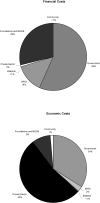National mass drug administration costs for lymphatic filariasis elimination
- PMID: 17989784
- PMCID: PMC2041814
- DOI: 10.1371/journal.pntd.0000067
National mass drug administration costs for lymphatic filariasis elimination
Abstract
Background: Because lymphatic filariasis (LF) elimination efforts are hampered by a dearth of economic information about the cost of mass drug administration (MDA) programs (using either albendazole with diethylcarbamazine [DEC] or albendazole with ivermectin), a multicenter study was undertaken to determine the costs of MDA programs to interrupt transmission of infection with LF. Such results are particularly important because LF programs have the necessary diagnostic and treatment tools to eliminate the disease as a public health problem globally, and already by 2006, the Global Programme to Eliminate LF had initiated treatment programs covering over 400 million of the 1.3 billion people at risk.
Methodology/principal findings: To obtain annual costs to carry out the MDA strategy, researchers from seven countries developed and followed a common cost analysis protocol designed to estimate 1) the total annual cost of the LF program, 2) the average cost per person treated, and 3) the relative contributions of the endemic countries and the external partners. Costs per person treated ranged from $0.06 to $2.23. Principal reasons for the variation were 1) the age (newness) of the MDA program, 2) the use of volunteers, and 3) the size of the population treated. Substantial contributions by governments were documented - generally 60%-90% of program operation costs, excluding costs of donated medications.
Conclusions/significance: MDA for LF elimination is comparatively inexpensive in relation to most other public health programs. Governments and communities make the predominant financial contributions to actual MDA implementation, not counting the cost of the drugs themselves. The results highlight the impact of the use of volunteers on program costs and provide specific cost data for 7 different countries that can be used as a basis both for modifying current programs and for developing new ones.
Conflict of interest statement
The authors have declared that no competing interests exist.
Figures
References
-
- World Health Organization. Global Programme to Eliminate Lymphatic Filariasis. WER. 2006;81(22):221–232. - PubMed
-
- Ramaiah K, Das P, Michael E, Guyatt H. The economic burden of lymphatic filariasis in India. Parasitology Today. 2000;16(6):251–253. - PubMed
-
- Gyapong J, Gyapong M, Evans D, Aikins M, Adjei S. The economic burden of lymphatic filariasis in northern Ghana. Annals of Tropical Medicine & Parasitology. 1996;90(1):39–48. - PubMed
-
- UN Office of the High Representative for the Least Developed Countries. List of Least Developed Countries. Available at: http://www.un.org/special-rep/ohrlls/ldc/list.htm. Accessed November 15, 2005.
Publication types
MeSH terms
Substances
LinkOut - more resources
Full Text Sources
Research Materials



